Smartphone cameras have undergone an impressive transformation, evolving from their humble beginnings to now rivaling the capabilities of professional cameras. Pioneering the charge, the realme GT 6 has emerged as a formidable contender in the photography arena.
This leap forward is attributed to the blend of the groundbreaking Sony LYT-808 sensor with the Snapdragon 8s Gen 3 chipset, a synergistic combination that amplifies image quality, particularly in challenging lighting scenarios. This partnership, branded as Geek Power Tuning, is the cornerstone of realme GT 6’s performance, enabling it to deliver a caliber of photo processing that competes with high-end cameras.
At the core of the realme GT 6’s camera system is the 50-megapixel Sony LYT-808 main camera sensor. Its large size and wide aperture are instrumental in capturing more light, ensuring photos are bright and clear. It goes a step further with 4K Dolby Vision video recording capabilities, offering a premium medium to record the world’s splendor with rich detail and vibrant colors.
Additionally, the phone features a 50-megapixel telephoto lens with an impressive 47mm equivalent focal length. This lens is adept at capturing stunning portraits as well as expansive landscapes, maintaining high-quality imagery in a diverse array of photographic conditions. This careful integration of high-resolution sensors means that even low-light photos are produced with exceptional clarity and minimal noise, setting a new benchmark for mobile photography.
Smartphone cameras have significantly evolved, offering professional-level photography capabilities in the palm of your hand. Various technological advancements, such as high-resolution sensors and sophisticated computational algorithms, contribute to this innovative leap.
The realme GT 6 is recognized for its exceptional photography performance, largely thanks to:
Sony LYT-808 Sensor: This sensor is particularly tailored for enhanced low-light photography, capturing a high degree of detail and a wider dynamic range.
Snapdragon 8s Gen 3 chipset: This chipset enables powerful processing, including real-time algorithms for image enhancement. It works in concert with the camera sensor to optimize image quality.
Important questions to consider:
1. How does the realme GT 6 camera compare to other smartphones?
The realme GT 6 competes with other flagship smartphones by offering a blend of high-resolution sensors and advanced processing capabilities.
2. Can the realme GT 6 replace a professional camera?
While the realme GT 6 offers advanced features, professional cameras may still excel in certain aspects such as lens variety, sensor size, and manual controls.
3. What challenges do smartphone manufacturers face in improving camera technology?
Key challenges include balancing space constraints within a smartphone’s slim form factor while integrating larger sensors and maintaining image quality at high zoom levels.
Controversies associated with smartphone photography:
One debate is around the ‘authenticity’ of images, as computational photography can dramatically alter a photo from what was originally captured.
Advantages of Smartphone Photography:
– Portability: Smartphones are light and easy to carry, making photography accessible everywhere you go.
– Connectivity: Instantly share your photos across various platforms directly from the device.
Disadvantages of Smartphone Photography:
– Limited Sensor Size: Smaller sensors can struggle in extremely low light conditions compared to those in DSLRs or mirrorless cameras.
– Battery Life: Intensive camera use can drain a smartphone’s battery quickly.
Relevant related links include:
– Sony for information on the latest camera sensors.
– Qualcomm for the latest on Snapdragon chipsets.
Remember, this is merely supplementary information that adds to the topic of the original article, which highlights the innovative leap in smartphone photography, epitomized by the realme GT 6 camera’s capabilities.
